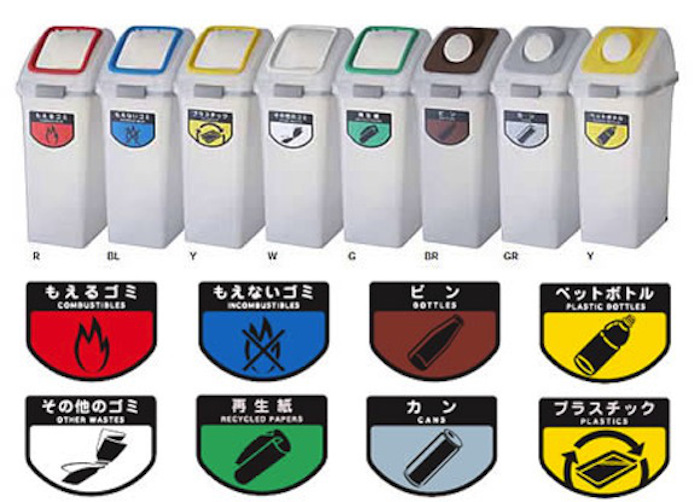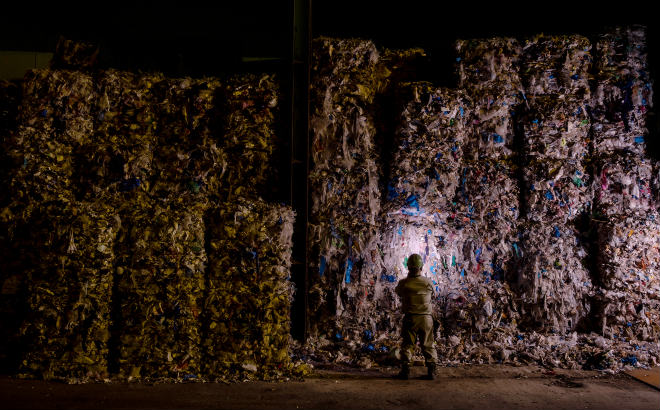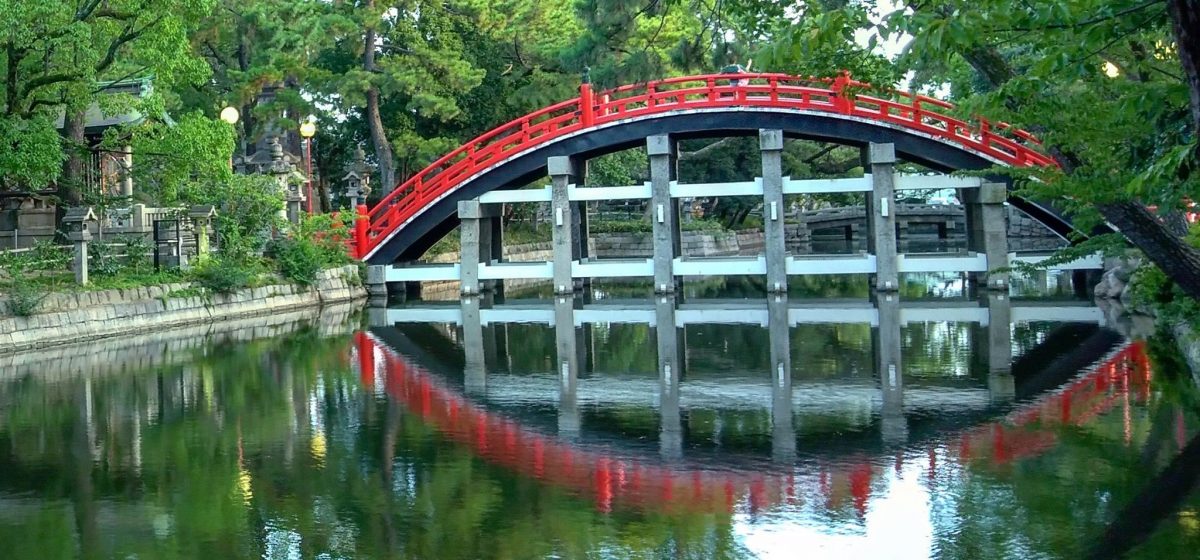Getting Trashed in Japan
By Richard Trombly
Every new place you go to in Japan seems to present a different set of rules for分別bunbetsu, (classification or separation of trash) and the process can seem confusing. In some serviced apartments, shared living spaces and housing developments, the residents need to do very little sorting, as facility management handles the dirty work. But if you move out to a house or flat on your own, the rules can seem daunting.
Some individual apartment building, housing complex or whole neighborhood may share a long series of labeled trash bins with strict rules for separation of waste and various classifications of recyclables. More rural neighborhoods tend to have scheduled curbside pickups but the angst around separation is no less critical. Each complex or neighborhood will have its own system and when you register your address, you will get information about the local rules.

The four basic categories are burnable, non-burnable, recyclables and plastics. There is a certain gray area for some items, so study the rules closely to be free of “separation anxiety.” In most places, you have to wash and dry the recyclables and divide the PET bottles, beverage cans, glass bottles and recyclable paper and cardboard. There is a fifth category of trash known as “oversized” garbage but that also includes items like old electronics and electrical devices that require special handling and each city has a system to schedule pickups. There is a fee that must be paid per item with tax stamps that can be purchased at the post office and in some cases are available at local convenience stores.
If you have curbside pickups, each of these may be collected on a different schedule, so you may find yourself bringing something out every morning of the week. Many towns will require specific bags which will be available in supermarkets, convenience stores and 100 yen shops. There might even be different color bags for different types of trash and a voucher system to limit the number of bags used per person each year.
If you don’t properly handle your trash, sanitation workers might tag the bag with a refusal sticker and leave it behind, which will publicly shame the offender. Further violations may lead to fines. Also keep the workers safe. If you are discarding broken glass or sharp objects, wrap the sharp edges and mark the bag as キケンkiken (hazardous.) Remember to make your life and the lives of the sanitation workers easier by assuring that you sort properly and use the correct bags.
Fantastic plastic
Despite all the efforts to effectively and efficiently handle recycling, Japan has a huge problem with consumption, most notably with plastics. Japan’s annual production of single-use plastics topped 9.4 million tones. It is seeking to reduce that 25 percent by 2030 as part of a commitment to the 3Rs (reduce, reuse and recycle.)
Japan has a high standard of customer service and a high standard of living. In the modern world, that has lead to a love affair with convenience and consumerism resulting in a deluge of single-use plastic. Every consumer item seems to be heavily overpackaged, in big boxes and plastic cases, or wrapped in plastic sheeting. Also, there are so many plastic items that were designed to be discarded like straws and utensils. Shopping for groceries will inevitably lead to aisles of single pieces of fruit or vegetable showcased on a Styrofoam tray wrapped heavily in a cocoon of plastic. It seems like there is no end in sight, but a new policy may give Japanese people cause to examine their plastic habit.
Major chains like Aeon and Ito-Yokado were forward thinking and have already adopted the practice of charging for plastic bags. Starting in July 2020, this will be mandated across the nation. The initiative to reduce plastic waste involves banning free plastic bags and encouraging reusable bags. Japan currently discards about 30 billion bags a year, yet that accounts for only about 2 percent of the annual plastic waste.“The proportion of plastic bags among plastic waste is not big, but charging would be symbolic,” said Environment Minister Yoshiaki Harada in a June 2019 press briefing.
Global concerns
Countries around the world are grappling with the ever-increasing concern of handling garbage but in few places is it as critical as the mountainous islands that make up Japan. The country’s 1,661 landfills have remaining capacity of 100 million cubic meters. At the current rate of consumption, the nation’s dumps will be filled to capacity by 2040, according to the Ministry of the Environment.
Much of the waste produced in Japan is incinerated, which does keep it out of the landfills but contributes to air pollution and global warming. Trash generation has decreased from a peak of nearly 1200 g of daily waste per capita in the late 1990s to a current rate of about 950 g according to EU-Japan Centre for Industrial Cooperation. Clearly, however, other measures are needed to address this growing concern.

Osaka hosted the 2019 G20 Summit, an annual meeting of finance ministers and central bank governors, where there was special emphasis placed on implementation of the 3R policy in Asia. Though Japan has a well-defined recycling framework, it only recycles about 20 percent of its municipal waste while Germany leads the world at 65 percent and S. Korea at 59 percent, according to the Organisation for Economic Co-operation and Development. Japan’s industries produce nearly 10 times the amount of waste annually compared to households. With stringent standards on industrial recycling and waste management, recycling rates approach 50 percent but industrial waste remains a significant problem.
Japan refused to sign a 2018 G7 ocean plastics charter, despite 60,000 tonnes of the over 8 million tonnes of plastics entering the ocean annually originating from Japan. Introducing an agreement to reduce marine plastic became a focus for Japan at the 2019 summit.
Getting Burned
While Japan has made the claim of recycling over 85 percent of its plastic waste, up to 20 percent is exported and a vast portion of the remainder undergoes so-called “thermal recycling,” in other words it is incinerated for the heating value.Though it produces thermal energy from waste, most countries would not consider that as recycling. The “clean incineration” process does remove many of the toxins from the exhaust but still produces CO2 and other pollutants.
Japan does rate highly in other areas of recycling. The metal recycling rate approaches 98% and beverage cans have a recycling ratio of 87.4 percent. Furthermore Japan recycled 498,000 tonnes of PET bottles for a recycling rate of 84.8 percent. The majority of electronic appliances and electrical products are recycled with up to 89 percent of the materials recovered.

So why is the overall recycling rate for municipal trash among the lowest in the OECD countries? Foods and consumer goods are heavily over-packaged and consumption remains high. The ubiquitous presence of convenience stores might be seen as a sign of the Japanese addiction to consumerism.
Another answer to the waste equation is food waste which is incinerated. About 20 percent of the overall waste produced in the country is household food waste, according to the Ministry of Agriculture, Forestry, and Fisheries. This accounts for a staggering 6.5 million tonnes annually. Combined with the huge amount of food that expires on retailers’ shelves or in wholesalers’ warehouses without ever reaching the consumer, it is clear that there is a huge disconnect with the need to reduce waste. It is also of critical importance because Japan is only 40 percent self-reliant in terms of food production.
Trash and Carry
Since Japan does not have public trash bins, the need for reducing consumption becomes abundantly clear when traveling. Tourists or even anyone just roving about town meet with the challenge of the trash they create. Since you must pack it with you until you get home, you have time to consider reducing your trash footprint. The Covid 19 emergency has intensified this inconvenience. Most supermarkets and convenience stores previously offered recycling and waste bins for customers but many have suspended this service to reduce virus transmission. Drink bottles and cans may still be dropped in bins alongside most vending machines but other trash should not be deposited there.
One thing is clear, for Japan to successfully face the future, we will all have to examine ways in which we can change our lifestyles and our buying habits.
The rules for Osaka waste management can be found at this link: https://www.city.osaka.lg.jp/contents/wdu020/enjoy/en/content_f.html
The rules for Kyoto waste management can be found at this link:
The rules for Kobe waste management can be found at this link:

